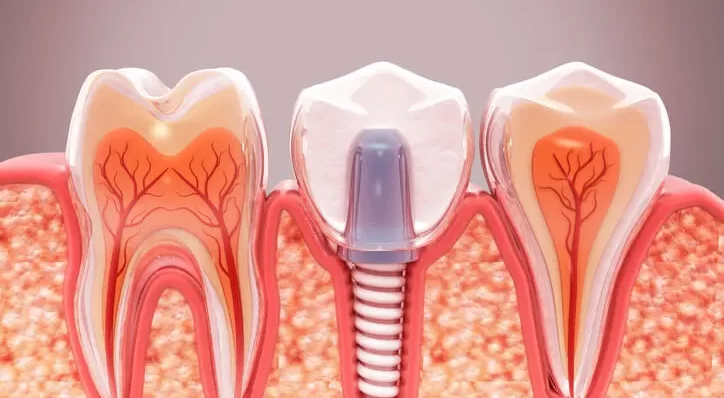In the realm of restorative dentistry, implant crowns stand as a remarkable solution for replacing missing teeth. These prosthetic devices offer both functional and aesthetic benefits, mirroring the appearance and function of natural teeth. Implant crowns have revolutionized dental care, providing patients with a reliable and durable option for restoring their smiles. This comprehensive guide delves into the intricacies of implant crowns, exploring their purpose, types, procedures, maintenance, and the benefits they offer.
Table of Contents
ToggleWhat Are Implant Crowns?
Implant crowns are artificial tooth replacements used in cases of missing teeth. They consist of two primary components: the implant, which serves as an artificial tooth root, and the crown, the visible portion resembling a natural tooth. The implant is typically made of titanium, a biocompatible material that integrates with the jawbone through a process called osseointegration. The crown, often made of materials like porcelain or ceramic, is custom-designed to match the color, size, and shape of the patient’s natural teeth, ensuring a seamless appearance.
Types of Implant Crowns
Several types of implant crowns exist, each tailored to meet specific patient needs:
- Single-Tooth Implant Crown
- Multiple-Tooth Implant Crown
- Full-Arch Implant Crown
Single-Tooth Implant Crown
Utilized when a single tooth needs replacement. It involves an individual implant and crown, providing an independent solution for a missing tooth.
Multiple-Tooth Implant Crown
Employed when multiple adjacent teeth are missing. This involves multiple implants supporting a bridge or several crowns.
Full-Arch Implant Crown
Utilized when an entire arch of teeth requires replacement. This technique involves a series of implants supporting a full set of prosthetic teeth.
Implant Crown Categories
Implant crowns can be categorized based on how they are fixed or attached to the dental implant. There are primarily two types of implant crown fixation methods:
- Screw-Retained Implant Crowns
- Cement-Retained Implant Crowns
Screw-Retained Implant Crowns
- Mechanism: These crowns are secured onto the implant abutment using a screw.
- Process: The crown is fabricated with a screw access hole, allowing it to be firmly attached to the implant abutment with a screw. This connection provides stability and strength to the restoration.
- Advantages: Easy removal for maintenance or repairs without compromising the entire implant structure. They offer simplicity in retrievability and can be more beneficial in situations where frequent maintenance might be necessary.
Cement-Retained Implant Crowns
- Mechanism: These crowns are affixed to the implant abutment using dental cement.
- Process: The crown is placed onto the abutment and secured by dental cement, creating a seamless and natural appearance. The cementation process helps in providing a strong bond between the crown and abutment.
- Advantages: Aesthetic appeal as there is no visible screw access hole, leading to a more natural look. Additionally, cement-retained crowns can eliminate the risk of screw loosening over time.
The choice between screw-retained and cement-retained implant crowns often depends on various factors including the dentist’s preference, the location of the implant, aesthetic considerations, and the ease of maintenance or repair. Each method has its own set of advantages and potential drawbacks, which should be discussed with the patient to determine the most suitable option based on their specific needs and the clinician’s assessment.
It’s important to note that while both types of fixation methods have their merits, the decision should be made considering factors such as ease of retrieval, aesthetics, potential for complications, and the long-term maintenance of the implant crown.
Implant Crown Procedure
The process of getting an implant crown typically involves several stages:
- Consultation and Evaluation
- Implant Placement
- Abutment Placement
- Crown Placement
Consultation and Evaluation
The dentist assesses the patient’s oral health, discusses treatment options, and develops a personalized plan.
Implant Placement
A minor surgical procedure is performed to place the implant into the jawbone. Over several months, osseointegration occurs as the bone fuses with the implant.
Abutment Placement
Once osseointegration is successful, an abutment is attached to the implant, providing a connection for the crown.
Crown Placement
The final step involves the fabrication and placement of the custom-designed crown onto the abutment, completing the restoration.
Benefits of Implant Crowns
Implant crowns offer numerous advantages:
- Aesthetics
- Functionality
- Durability
- Bone Preservation
Aesthetics
They closely resemble natural teeth, enhancing the smile’s appearance.
Functionality
Implant crowns restore proper biting and chewing functions, promoting better oral health.
Durability
With proper care, implant crowns can last a lifetime, providing a long-term solution for missing teeth.
Bone Preservation
Implants stimulate the jawbone, preventing bone loss commonly associated with missing teeth.
Maintenance and Care
Proper maintenance is crucial for the longevity of implant crowns:
- Oral Hygiene
- Dental Visits
- Avoiding Damage
- Lifestyle Factors
Oral Hygiene
Regular brushing, flossing, and using mouthwash help prevent plaque buildup and maintain oral health.
Dental Visits
Routine dental check-ups and professional cleanings are essential to monitor the condition of the implant crowns.
Avoiding Damage
Avoid chewing hard objects or using teeth as tools to prevent damage to the crowns.
Lifestyle Factors
Healthy habits, such as a balanced diet and avoiding tobacco products, contribute to the overall health of implant crowns.
Possible Complications
While implant crowns are generally successful, complications may arise, including:
- Infection at the Implant Site
- Implant Failure
- Peri-implantitis
Infection at the Implant Site
Proper oral hygiene and following post-operative care instructions minimize this risk.
Implant Failure
Factors such as poor bone quality or improper placement may lead to implant failure, requiring additional treatment.
Peri-implantitis
Inflammation around the implant site due to bacterial infection (peri-implantitis) can compromise the implant’s stability.
Conclusion
Implant crowns have revolutionized the field of dentistry, offering a reliable and aesthetically pleasing solution for missing teeth. Understanding the types, procedures, benefits, maintenance, and potential complications associated with implant crowns is essential for both patients and dental professionals. With proper care and regular dental visits, implant crowns can provide patients with restored confidence, functionality, and a natural-looking smile for years to come.

